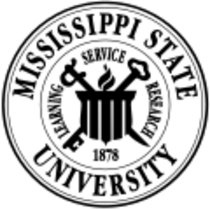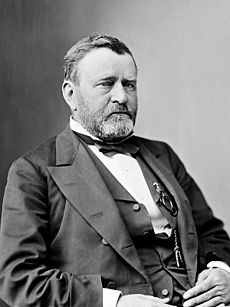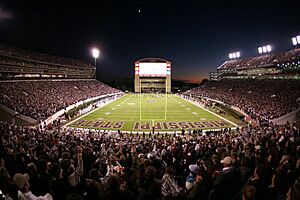Mississippi State University facts for kids
|
Mississippi State University for Agriculture and Applied Sciences
|
|
 |
|
|
Former names
|
The Agricultural and Mechanical College of the State of Mississippi (1878–1932) Mississippi State College (1932–1958) |
|---|---|
| Motto | "Learning, Service, Research" |
| Type | Public land-grant research university |
| Established | February 28, 1878 |
|
Parent institution
|
Mississippi Institutions of Higher Learning |
| Accreditation | SACS |
|
Academic affiliation
|
|
| Endowment | $894.5 million (2024) |
| President | Mark E. Keenum |
|
Academic staff
|
1,359 |
|
Administrative staff
|
3,361 |
| Students | 23,150 (fall 2024) |
| Location |
,
,
United States
33°27′14″N 88°47′20″W / 33.454°N 88.789°W |
| Campus | Remote town, 4,200 acres (17 km2) |
| Other campuses | |
| Newspaper | The Reflector |
| Colors | Maroon and White |
| Nickname | Bulldogs |
|
Sporting affiliations
|
NCAA Division I FBS – SEC |
| Mascot | Bully the Bulldog |
 |
|
Mississippi State University (MSU) is a large public university in Mississippi State, Mississippi. It is known for its strong focus on research, especially in agriculture and applied sciences. MSU is considered a top research university, meaning it does a lot of important scientific studies. It has the biggest research budget in Mississippi.
The university started on February 28, 1878, as the Mississippi Agricultural & Mechanical College. It welcomed its first students in 1880. Today, MSU offers more than 180 different study programs. These include degrees in architecture and veterinary medicine, which are the only accredited programs of their kind in Mississippi.
MSU also takes part in special national programs. These include the National Sea Grant College Program, which focuses on ocean and coastal research, and the National Space Grant College and Fellowship Program, which supports space-related studies. Besides its main campus, MSU has smaller campuses in Meridian, Gautier, and Biloxi.
The university's sports teams are called the Mississippi State Bulldogs. They play in NCAA Division I and are part of the Southeastern Conference (SEC). MSU was one of the first members of the SEC back in 1932. The Bulldogs have won many championships over the years. They are especially famous for their baseball team. Their home field, Dudy Noble Field, Polk–DeMent Stadium, holds records for the most fans at college baseball games.
Contents
University History and Growth
Mississippi State University began as the Agricultural and Mechanical College of the State of Mississippi. It was one of the first "land-grant" colleges in the country. These colleges were created by the Morrill Act of 1862. The Mississippi Legislature started the college on February 28, 1878. Its goal was to teach about farming, gardening, and mechanical skills. It also included other science and classic subjects, plus military training. The first students arrived in the fall of 1880.
Over the years, the university's mission grew. In 1932, its name changed to Mississippi State College. This change showed that it was offering more than just agriculture and mechanical arts.
In 1958, the university was renamed Mississippi State University. This new name recognized its growth in academics and new graduate programs. By then, it had started a Graduate School in 1936 and doctoral degree programs in 1951. New colleges like the School of Forest Resources (1954) and the College of Arts and Sciences (1956) were also added.
In July 1965, Richard E. Holmes became the first African-American student to enroll. This was an important step for the university.
Later, new schools were added. The School of Architecture opened in 1973. The College of Veterinary Medicine welcomed its first class in 1977. The MSU Vet school is known for being the largest veterinary school under one roof in the nation. The School of Accountancy was also created in 1979.
The University Honors Program started in 1968. It offered more challenging courses and brought in guest speakers. This program has now grown into its own college, the Judy and Bobby Shackouls Honors College.
In March 2009, Mississippi State finished a big fundraising effort. They received over $462 million in gifts and promises. This money helps the university continue to grow and improve.
Exploring the Campuses
The main campus of Mississippi State University is mostly in the town of Mississippi State, Mississippi. A small part of it is in nearby Starkville.
The Drill Field: Campus Heart
The main part of MSU's campus is the Drill Field. This large grassy area was once used for military drills. Today, it's a central gathering spot. Important buildings like Lee Hall and Swalm Hall are at its ends. The Mitchell Memorial Library is also on the Drill Field.
Beyond the main campus are the North and South Farms. These areas are still used for farming research. But they also have modern facilities. For example, the South Farm has an astronomical observatory and the Veterinary College. The North Farm is home to the High Performance Computing Collaboratory.
On the far west side of campus, you'll find fraternity and sorority houses. Beyond them are the the Cotton District and downtown Starkville. The university also has the Thad Cochran Research, Technology and Economic Development Park. This park hosts many research centers, like the Center for Advanced Vehicular Systems (CAVS).
Mississippi State University also has other locations. It runs a degree-granting center in Meridian, Mississippi. This center offers both undergraduate and graduate programs. The College of Engineering also offers a Master of Science degree in Vicksburg, Mississippi.
Mitchell Memorial Library: A Treasure Trove
The Mitchell Memorial Library is right in the middle of campus. It has a huge collection of books and journals.
One special thing about this library is that it holds important historical papers. Since May 2012, it has been the permanent home for Ulysses S. Grant's Presidential Library. This collection includes Grant's letters and photos from when he was president (1869-1877).
The library also has the Congressional and Political Research Center. This center holds the papers of US Senator John C. Stennis and Congressman G. V. Montgomery. Their careers in Congress lasted a total of 72 years.
Another unique collection belongs to the famous author John Grisham. He is an MSU alumnus and donated his papers to the university in 1989. You can see items from his collection in the John Grisham Room on the library's third floor.
In 2000, the Charles H. Templeton Collection came to the library. This amazing collection includes over 200 old music instruments. It also has 22,000 pieces of sheet music and 13,000 records. It's known for having one of the most complete collections of Victor Talking Machines from 1897 to 1930. You can see items from this collection at the Templeton Music Museum.
The library also hosts the Charles Templeton Ragtime Jazz Festival every year. This event includes talks and live performances of ragtime and jazz music. It started in March 2007 and is the first of its kind in Mississippi.
The Junction: A Modern Gathering Place
The Junction is a central area on campus. It used to be a confusing intersection of roads. But it was redesigned to be a pedestrian-friendly space. Now, it has green areas for relaxing and events, like football tailgating.
The Junction is near Davis Wade Stadium, the Barnes & Noble Bookstore, and the University Welcome Center. It's a key spot for students, alumni, and visitors to meet. Paved walkways connect it to the historic Drill Field.
Academics and Learning at MSU
| ARWU World | 501 |
|---|---|
| THES World | 601–800 |
| USNWR National University | 214 (tie) |
| Washington Monthly National University | 254 |
| Forbes | 242 |
U.S. News & World Report National Rankings
| Graduate school | 2024 national rank |
|---|---|
| Veterinary Medicine | 24 |
| Engineering | 80 |
Mississippi State University is officially recognized to offer many types of degrees. These include bachelor's, master's, specialist, and doctoral degrees. The university has several colleges and schools where students can study:
|
|
In fall 2021, over 23,000 students were enrolled at Mississippi State. The university has 160 buildings. Its grounds cover about 4,200 acres, including farms and woodlands. The university also owns another 80,000 acres across the state.
Student Life and Activities
| Race and ethnicity | Total | ||
|---|---|---|---|
| White | 74% |
|
|
| Black | 15% |
|
|
| Hispanic | 4% |
|
|
| Two or more races | 3% |
|
|
| Asian | 2% |
|
|
| International student | 1% |
|
|
| Unknown | 1% |
|
|
| Economic diversity | |||
| Low-income | 29% |
|
|
| Affluent | 71% |
|
|
MSU has more than 300 student groups. These include the Student Association, the Famous Maroon Band, and many others. There are also 18 fraternities and 11 sororities. The University Recreation department offers many intramural sports. Many international student organizations are also active on campus.
Student Media and News
Mississippi State has its own local radio station, WMSV.
The student newspaper is called The Reflector. It is published twice a week. In 2007, it was named the best college newspaper in the South. It has continued to be one of the top college newspapers in the region.
Music and Entertainment
The campus radio station, WMSV, plays music for students.
Every spring, the Old Main Music Festival takes place on campus. It's free for everyone to enjoy.
The city of Starkville and the MSU campus have hosted many famous artists. In 1965, Johnny Cash performed there. His experience in Starkville even inspired him to write the song "Starkville City Jail."
Guest Speakers and Lectures
Each semester, Mississippi State invites many important speakers. Past guests have included best-selling authors like John Grisham. Other notable speakers include former United States Secretary of State Condoleezza Rice and film director Spike Lee. Science show hosts like Dr. Neil deGrasse Tyson have also visited. Even Nobel Prize winners have given talks at MSU.
Greek Life at MSU
Mississippi State has a Greek system with 20 fraternities and 14 sororities. In 2019, about 24% of undergraduate men and 18% of undergraduate women were part of a Greek organization.
Sports: Go Bulldogs!
Mississippi State University has 16 athletic teams, known as the Bulldogs. They used to be called the Aggies or the Maroons. They compete in Division I of the NCAA. They are part of the 16-member Southeastern Conference (SEC).
The Bulldogs have won 28 conference championships, including 14 in the SEC. Their most successful sport is baseball. The Diamond Dogs, as they are called, have won 17 conference championships and 6 SEC tournament championships. They have also made 28 NCAA Tournament appearances and 12 College World Series appearances.
The Diamond Dogs play their home games at Dudy Noble Field, Polk-DeMent Stadium. This stadium holds the NCAA record for the largest crowd at a college baseball game on campus. On April 15, 2023, 16,423 fans watched them play against Ole Miss. After finishing second in 2013, the Diamond Dogs won their first Men's College World Series in 2021. This was the university's first national championship in any sport!
Famous People from MSU
Many notable people have studied or worked at Mississippi State University.
See also
 In Spanish: Universidad Estatal de Misisipi para niños
In Spanish: Universidad Estatal de Misisipi para niños
- List of agricultural universities and colleges
- List of architecture schools
- List of business schools in the United States
- List of engineering schools
- List of forestry universities and colleges
- List of land-grant universities
- List of schools of landscape architecture
- List of research universities in the United States
- List of schools of veterinary medicine





